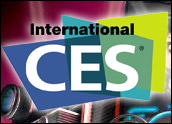
3-D is definitely not just for cheesy drive-in movies anymore. It’s done great box office with animated films, and that big 3-D sci-fi action movie “Avatar” coming out this weekend has won over a lot of early reviewers, at least on a technical level.
But one of these days you won’t have to go out to a theater to see 3-D movies — you’ll just have to shell out thousands of dollars for a state-of-the-art home system. The Blu-ray Disc Association has finalized specs for 3-D Blu-ray, and this year’s Consumer Electronics Show is expected to be an all-out orgy of 3-D technologies.
So, hypothetically, if you had the means and the desire to build your own personal 3-D theater in 2010, what would you need?
First off, glasses. 3-D doesn’t happen all by itself. But they won’t be the red and blue kind from the ’50s; new 3-D technology will not make the entire movie look purple. You might also need a new Blu-ray player if you don’t already have a fairly new one. The PlayStation 3 will be able to give you 3-D content; with others, it’s going to depend on the model.
Then there’s your TV itself, which will probably need a boost too. In order to play 3-D movies, you have to have a TV that refreshes its images at a relatively fast rate — like 120 Hz. Those do exist, but they’re a bit pricey, and they haven’t been around all that long, so unless you’ve bought an upscale flatscreen in the last few months, you’re probably not up to snuff for 3-D.
And then there are the discs — you’ve got to buy new 3-D discs. The good news is that everything’s backward compatible: 3-D discs will play on 2-D players with normal flat images, and 3-D Blu-ray players will still play all your old 2-D discs.
If all that sounds expensive, it is. The whole package could easily cost two grand — more if you want anything better than bare minimum specs. That’s a lot of IMAX tickets, but at least the popcorn at home is cheaper.
Not Too Big to Fail
Apple may have changed some minds about desktop computers with its latest version of the iMac. More and more consumers have been going with laptops over the last few years, but Apple went and put this beautiful, giant 27-inch screen on its latest iMacs, threw in some powerful guts, and then slapped a pretty attractive price on the whole package — relatively speaking, of course.
But a few customers who ordered a big, new iMac recently had a pretty rotten experience when it finally arrived and they opened the box. Mac-related blogs and other Web sites have seen a spike in comments from buyers about discolored displays and processor problems. Keep in mind, this is only a few hundred out of many thousands of orders, but it definitely appears to be a bigger problem than just a one-in-a-million lemon that any factory can put out from time to time. And when you think you’re getting a computer with such an incredible display and it ends up trying to pass off this sickly shade of yellow as true white, well, that’s just flat-out disappointing for a customer of any company, let alone Apple.
Other complaints include weird flickering, disappearing and reappearing black bars, periodic blackouts and unwanted appearances from menu bars.
This all might be traceable to the computers’ graphics cards. A lot of Macs use Nvidia hardware, but these have AMD ATI cards, and that’s the root of the problem, according to Broadpoint AmTech’s Brian Marshall.
Anyway, there’s evidence Apple is trying to fix things — there’s now a two-week delay on ordering new 27-inch iMacs, probably so it can sort out the problem.
Custody Battle
There’s a theory that the reason the Large Hadron Collider had so many technical problems was that the universe did not want it to work. It was being sabotaged by the impossibility of its own future, or something to that effect. Recent successes at CERN seem to indicate otherwise, so perhaps the theory is better applied to much simpler undertakings like tablet computer projects.
Actually, tablet PCs have been around for years, but they’re mostly these thick, heavy things that are basically just old-school touchscreen technology slapped onto a notebook computer. The next generation of tablets will be thin, light, quick to start up, and built for stuff like casually browsing the Web, playing video and music, and reading e-books. Or something like that, at least. Apple’s expected to deliver one soon, but I feel like I’ve been saying that for years — who knows when it’ll actually come to pass?
Elsewhere in Silicon Valley, tech blogger extraordinaire Michael Arrington had a vision about 18 months ago. He was tired of waiting for the tablet of his dreams, he wrote, so he was going to go out and make one himself — the so-called “Crunchpad,” named after his main blog, TechCrunch.
Now that dream is a reality — but Arrington is no longer in the picture. A startup called “Fusion Garage” intends to sell the device, now called the “JooJoo,” for about US$500 — but Arrington is not getting a cut. It’s the story of a partnership gone sour, and it goes something like this: After Arrington announced his intentions on TechCrunch back in 2008, Fusion Garage approached him. Founder Chandrasekar Rathakrishnan thought his company’s software would be perfect for the project, and Arrington agreed it had potential, so they settled on Fusion owning 35 percent of the Crunchpad venture, according to Arrington.
A few prototypes later, things got rocky. Fusion wasn’t happy with the design as of last February, so it kept hard at work; meanwhile, Arrington said he continued to bankroll the project to the tune of nearly half a million dollars. He also said he lined up at least $1 million in angel investments that would show up once the project was ready to roll.
But Rathakrishnan says CrunchPad’s team didn’t contribute a line of code or a dollar of funding. There was never agreement on the terms of an acquisition. In fact, there seems to have been no formal contract in place at all, which is odd considering Arrington used to work as a lawyer.
Then in late November, Arrington posted a message on TechCrunch that the deal was dead — Fusion Garage had walked out on Team CrunchPad and decided to sell the device on its own under the “JooJoo” name, even though Arrington maintained that neither side owned the rights. He’s filed suit to block Fusion Garage from making any sales, and he’s sewing seeds of doubt that the startup even has the money to start building the tablets. Meanwhile, Rathakrishnan has been courting the media and showing off a finalized JooJoo prototype. The slim, Web-browsing tablet with a 12.1-inch screen looks intriguing, but if Arrington has his way, the only place you’ll ever find it is in some future museum, sitting between a Palm Foleo and a copy of “Duke Nukem Forever.”
Rare Species
Google must have known this was going to happen. Unless threatened with summary execution, proud geeks will always want to show off their new toys, especially when that toy is unattainable by anyone outside the inner circle.
There’s been a rumor recently that the Google Phone is real. I’m not talking about the T-Mobile G1 or any other phone on the market with the Android OS. I’m talking about a phone branded by Google itself with a special edition of Android cooked up by the search company’s own developers. Now the rumor’s been verified — a Google employee using a prototype tweeted pictures of the device, and Google itself confirmed it’s real. A handful of Google employees have been given a so-called mobile lab to test (and definitely not lose). Another possible name is “Nexus One,” according to an FCC document Engadget dug up.
In verifying the thing’s existence, Google didn’t offer many details. It’s described as “innovative hardware from a partner with software that runs on Android to experiment with new mobile features and capabilities.”
Looks like there’s nothing for dinner but a big bowl of speculation, so let’s eat: First off, who’s the hardware partner? Well, HTC makes a lot of Android phones, and in the photo it looks like something they’d design. Who’s the carrier? Perhaps it’s T-Mobile, but it would be pretty cool if customers could pick their network when ordering the phone — that one comes from Kara Swisher at All Things Digital.
Then there’s this idea: The Nexus One might incorporate a 1 GHz Snapdragon processor, which would probably make it the most powerful smartphone on the market. It also might make it one of the most expensive, if it doesn’t get a fat subsidy from a carrier partner.
Intel in the Crosshairs
Just because Intel bought its way out of its legal problems with AMD doesn’t mean all its bogeymen are gone. In fact, a much scarier one is still circling overhead, and it just dropped its bombs.
The Federal Trade Commission has gone ahead and sued Intel after an investigation into some allegedly anticompetitive behaviors. The FTC’s Bureau of Competition Director Richard A. Feinstein didn’t pull any punches in describing what his agency thinks Intel’s been up to. Statements like “running roughshod over the principles of fair play” and “deliberate campaign to hamstring competitive threats to its monopoly” factored into the rhetoric. Specifically, the FTC says Intel’s been using carrot-and-stick motivation techniques to get major computer makers to favor its chips, using software tricks to fool performance tests, and unfairly extending its reach into graphics processors.
Of course Intel says it’s all malarkey. Price incentives to convince buyers to favor their products and buy in bulk? Sounds like Costco better run for cover. Intel’s Chief Counsel Doug Melamed said the FTC is “advocating new rules for regulating and micromanaging business conduct that would harm, not help, competition, and would cost money in research and development. It will not help the American consumers.”
So, are we looking at this decade’s version of U.S. vs. Microsoft? Intel says no way. The case against Microsoft was based on conservative principles, Redmond’s activities were deemed illegal because it didn’t have a very good reason to do them in the first place, and back then, the government actually did some legwork and built a solid case for itself. That’s all according to Intel — we’ll soon see how good a case the FTC has. It’s gonna be a good fight, though these sorts of big-league legal battles can really drag a company’s innovation down, and when that company’s a leader in the field, it could slow down the whole industry — or give someone else a big opportunity.
Browser Bind
Speaking of the U.S. vs. Microsoft, the company looks to be wrapping up a sort of miniature sequel to that old nightmare over in Europe. The European Commission has been giving Microsoft grief for almost a year over its practice of bundling its Internet Explorer browser in with its Windows operating system and making it the default browser out of the box.
Of course, IE has never prevented anyone from going to the Web site of a competing browser, downloading it and having it up and running as the default in under five minutes. Even so, Microsoft must now treat all of its European customers sort of like how we all treat that one member of the family who’s kind of slow with computers and needs a little extra help now and then.
Redmond will now have to issue an update that gives Europeans a more straightforward way to choose among a variety of browsers in addition to, or instead, of IE. Microsoft will also have to allow PC makers to install competing browsers, set them as the default, and turn off Internet Explorer. That last one doesn’t really sound like it would give the consumer a greater degree of control at all — it just transfers the decision from the software maker to the hardware maker. Go figure.
This sounds like a whole lot of fuss undertaken for the benefit of people who hear “Firefox” and think “old Clint Eastwood movie.” But the reality is that some people — a lot, in fact — really don’t care what browser they use as long as it works and it’s familiar, and when one very popular operating system sets the same default browser for all those users, it could affect Web designers’ decisions regarding what standards they follow.
In theory, if too many people are using the same browser, designers will get lazy and stop designing their sites to work with all browsers — they’ll just accommodate that single most popular one. If other browsers don’t work with a lot of sites, people stop using them and they go kaput. That’s the theory.
Give and Take
Meanwhile, Oracle may have just given up a very important inch or two in its fight with the European Commission to win approval for its purchase of Sun Microsystems.
Oracle’s bid to buy Sun got fast approval in the U.S., but Europe has been much more difficult to convince, mostly because of MySQL, a database product that belongs to Sun. The open source MySQL competes with Oracle products, and there’s fear that if the deal goes through, Oracle will kill, tie up, enslave, whip or otherwise subjugate MySQL in a way that stifles competition. Things would probably go down easy if Oracle just promised to give up MySQL, but it’s already said that’s not gonna happen.
So here’s Oracle’s latest offer of compromise: It won’t assert copyright claims over MySQL and it’ll extend terms and conditions of existing commercial licenses of the database for five years. So whatever grand scheme Larry Ellison has in store for MySQL, at least we all have a half a decade to get ready for it.
The EC has until January 27th to decide whether or not to approve the deal, but it’s already called the new offer “an important new element to be taken into account.” Kind of vague, but it sounds encouraging.
Running Out of Options
Psystar’s death rattle has been an annoying little chirp for a few months now, but it may finally be time to zip up the body bag.
A few weeks ago in this podcast, I told you that a judge had issued a permanent injunction in November. That was not actually true then — sorry for the confusion. At that point, Apple had only asked for a permanent injunction. But it is true now. The motion was granted this week, and Psystar cannot legally sell anyone a Mac clone computer. It’s also been banned from selling software that makes it possible to build a non-Apple computer that runs OS X — in other words, the Mac clone secret sauce.
A few weeks ago, it looked as though Psystar was attempting to reposition itself to sell something called “Rebel EFI” to consumers directly and allow them to make their own illicit Macs. That plan clearly won’t work out now, right?
Well, Psystar does have one very slim margin for maneuvering, but it risks irking the judge to the point of a contempt of court charge. Apparently Psystar has been very cagey in describing exactly what Rebel EFI is or what it does, and without that information, the court couldn’t be very specific in telling Psystar exactly what it could not sell. Conceivably — and this is only if Psystar really wants to go for broke — the company could start selling Rebel EFI and then do its best to fight off the charges when it’s inevitably hauled back to court. That would be very crazy, but nothing in Psystar’s past really suggests it errs on the side of sanity.
Well aware of what’s going on here, the court has warned Psystar that it if chooses to go ahead with Rebel EFI sales, it does so “at its peril.”











































